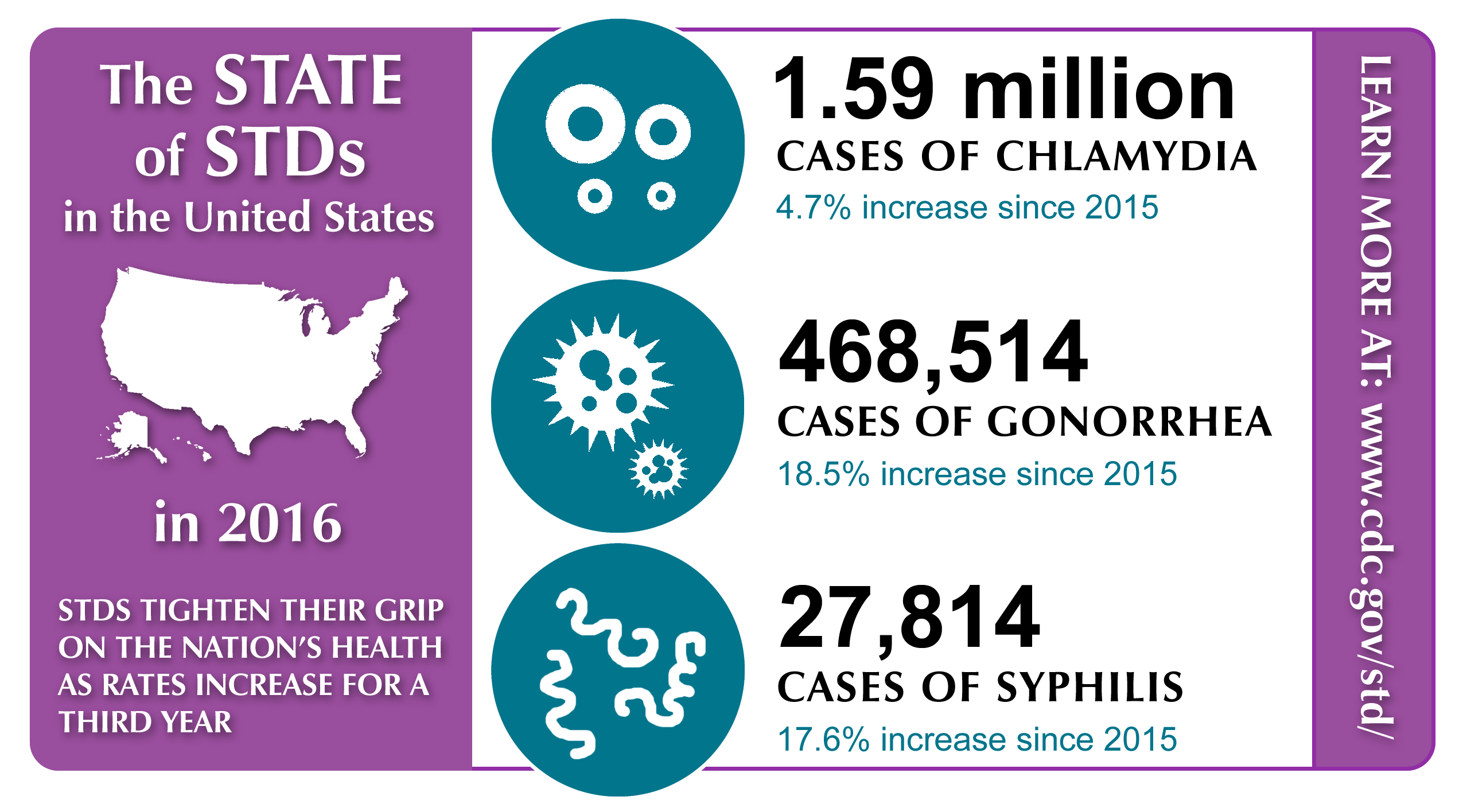Increasing STD rates highlight the need to work together, commit to doing what we know works, and develop new tools and approaches to address persistent challenges and emerging threats.
Today, the Centers for Disease Control and Prevention (CDC) released the Sexually Transmitted Disease (STD) Surveillance Report, 2016. For a third year in a row, rates for chlamydia, gonorrhea, and syphilis are increasing. While STDs can impact anyone, the report underscores how disparities are deepening for the hardest-hit and most vulnerable groups, including youth, men who have sex with men (MSM), and pregnant women. Reversing these trends will require health departments, healthcare providers, community organizations, community members, CDC, and other stakeholders to work together to more effectively implement prevention strategies that we know work, and develop new tools and approaches to address what isn’t working and respond to persistent challenges and emerging threats. 
“We need to double down on efforts to ensure barrier-free access to affordable sexual health services, including condoms and training for healthcare providers, that lead to improvements in screening and expedited partner treatment rates,” commented Dr. Barbara Ferrer, Director, Los Angeles County Department of Public Health, where STD rates continue to disproportionately affect people of color, including teenagers, women, transgender people, and MSM.
Local health departments (LHDs) across the country are heeding the call to double down on efforts by expanding evidence-based strategies to increase identification of STDs, assure appropriate clinical services for STD clients and their sexual partners, conduct health education and promotion, use surveillance data to inform programmatic efforts and focus on populations disproportionately impacted by STDs, and educate the public, providers, and key stakeholders on effective policy approaches.
In the District of Columbia, where national trends are mirrored with more than three years of increased cases of STDs, this call is being heeded. “Given the potential health consequences from STDs, DC has made reaching young people a top priority by advancing a number of sexual health initiatives, including school-based and community STD screening and treatment; a new sexual health campaign called Sex is… that aims to inform and support young people to make healthy decisions; and a revamped and rebranded STD clinic now known as the DC Health and Wellness Center, which offers a full range of sexual health services, including pre-exposure prophylaxis or PrEP,” explained Dr. LaQuandra S. Nesbitt, Director, District of Columbia Department of Health. “DC is also revising how to better respond to new STD infections and work with its medical and community providers to increase screening and reduce health impacts.”
As evidenced by these examples, LHDs are on the frontlines of our nation’s efforts to prevent and control STDs, and reverse the course of these concerning trends. LHDs work across the spectrum of public health, from surveillance to partner outreach, healthcare provider education to the direct provision of services via publicly-funded STD clinics, and from community engagement to collaborating with their HIV prevention and maternal and child health colleagues. According to NACCHO’s 2016 National Profile of Local health Departments, 65% of all LHDs screen for STDs and 63% provide STD treatment. These percentages increase significantly for health departments serving medium (50,000-499,999) and large (500,000) jurisdictions.
Efforts that are underway at the Florida Department of Health in Hillsborough County further highlight what it looks like to work across the spectrum of public health to address STDs. To achieve the Florida Department of Health’s strategic objective of reducing the number of congenital syphilis cases by 15% (per 2016 figures), Hillsborough County is implementing a number of approaches:
- Disease Intervention Specialists (DIS) are ensuring every syphilis report for a pregnant woman or a woman of reproductive age is thoroughly investigated and followed through, including ensuring they are receiving prenatal care and their sexual partners are receiving testing, examination, and treatment, as necessary.
- Surveillance staff routinely provide information to local healthcare providers about the CDC STD Treatment Guidelines.
- Surveillance supervisors conduct at least annual visits with local healthcare providers that are serving populations with high rates of STIs to share the latest data, information, and resources, including the STD Treatment Guidelines app.
Carlos Mercado, Director, Disease Control and Prevention, Florida Department of Health in Hillsborough County, and co-chair of NACCHO’s HIV, STI, and Viral Hepatitis Workgroup, notes that, “While these strategies are critical to our efforts to reduce cases of congenital syphilis, we still we have a lot of work to do in engaging and educating other community partners, such as faith-based organizations, to ensure that pregnant women and women of reproductive age have access to the care they need. 
At a time of increasing STD rates, it is critical that federal funding for STD prevention be increased. Emerging threats, such as antibiotic-resistant gonorrhea, combined with limited resources are wearing down our frontline of defense against STDs. We will not be able to reverse these trends without a meaningful investment in STD prevention and our public health infrastructure. NACCHO’s advocacy efforts focus on increasing understanding of the role of LHDs in communities, and advocating for adequate resources from the federal government. To learn more about how you can take action and educate Members of Congress about the importance of your work to prevent and control STDs, check out NACCHO’s Legislative Resources, and to learn more about what NACCHO is doing to support local health department STD programs, visit our HIV, STI, and Viral Hepatitis webpage.
View the 2016 STD Surveillance Report for access to a number of materials, findings, and key messages from the report, including a customizable infographic and social media graphics. We encourage you to use the surveillance data and these resources from the CDC to educate about STDs in your community.








